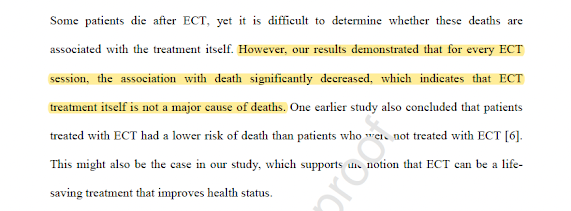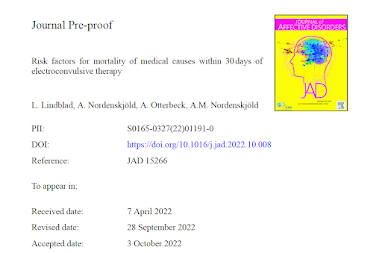Medical Causes of Mortality After ECT: New Study from Sweden
Out on PubMed, from Swedish investigators, is this study:
Risk factors for mortality of medical causes within 30 days of electroconvulsive therapy.
J Affect Disord. 2022 Oct 6:S0165-0327(22)01191-0. doi: 10.1016/j.jad.2022.10.008. Online ahead of print.PMID: 36209782
The abstract is copied below:
Background: Electroconvulsive therapy (ECT) is used to treat severe psychiatric disorders and is associated with reduced risk of suicide and all-cause mortality in patients with severe depression. We investigated the causes of death occurring shortly after ECT and identified potential risk factors for medical causes of death.
Methods: Patients treated with ECT between 2012 and 2018 were included in this Swedish register-based study. Multivariate binary logistic regression was used to calculate odds ratios for covariates to determine potential predictors of 30-day mortality.
Results: Of the 20,225 included patients, 93 (0.46 %) died of suicide and 123 (0.61 %) died of medical causes after ECT. Cardiovascular disease was the most common medical cause of death (n = 49, 40 %). An older age, a Charlson Comorbidity Index of 1 or more, atrial fibrillation, kidney disease, reflux disease, dementia, and cancer were associated with increased risk of death by medical causes.
Limitations: Real-life observational studies based on registry data may demonstrate associations, but cannot determine causality. If medical records had been available, we would be better able to determine if deaths were due to the ECT, anesthesia, pre-existing medical conditions, or the mental disorder.
Conclusions: ECT appears to be a low-risk medical procedure. Older individuals with severe somatic diseases have the highest risk of death and extra measures should be considered to optimize their medical health during the pre-ECT workup, and during and after ECT.
Keywords: Death; Electroconvulsive therapy; Medical risk factors.
The article is here.
And from the text:




When you have a good database, mine it! That's exactly what Swedish investigators, led by Axel Nordenskjöld, have done. Here's another excellent study, that, despite methodological limitations, shows the safety of ECT. The risks of older age and cardiac disease are obvious; the suicide risk in our patients is also duly noted, and a reason that ECT should be prescribed earlier and more, in appropriately selected patients.
All ECT practitioners will benefit from a careful read of this data-filled paper, ~ 20 minutes.





Thank you for bringing the study to attention. It is of course not surprising that old individuals with many diseases have increased risk of dying. I hope everyone understands that this is not because of the treatment with ECT. The main point of the study is that for everyone else, the risk of dying of medical causes is extremely low. Thus, in young individuals without known medical disorders, prolonging time to ECT with extensive pre-ECT workup may have a negative risk-benefit ratio, as it might result in unnecessary suicide.
ReplyDelete